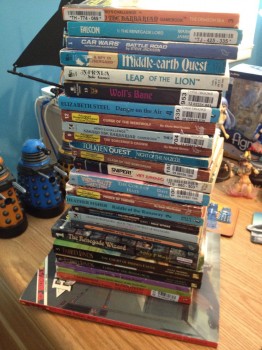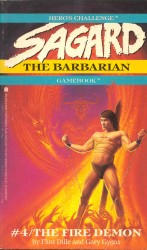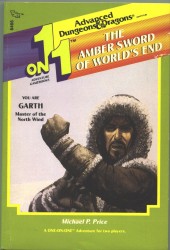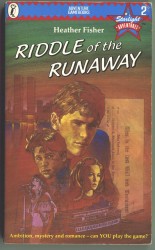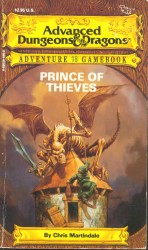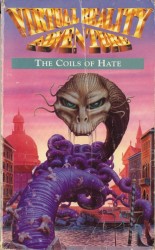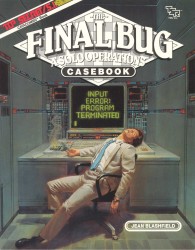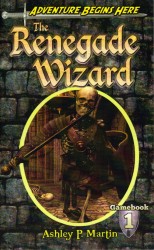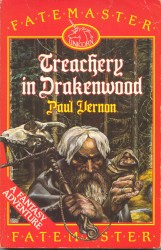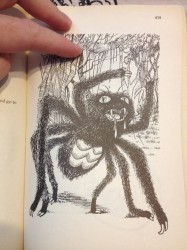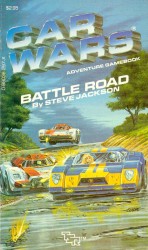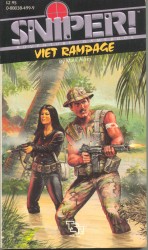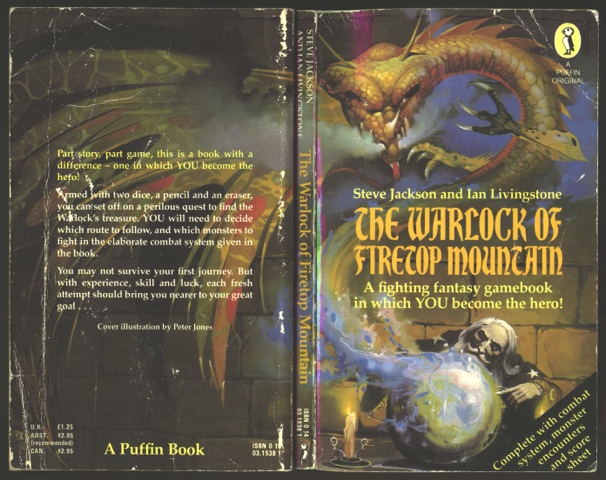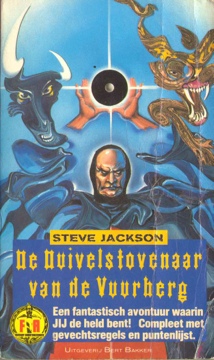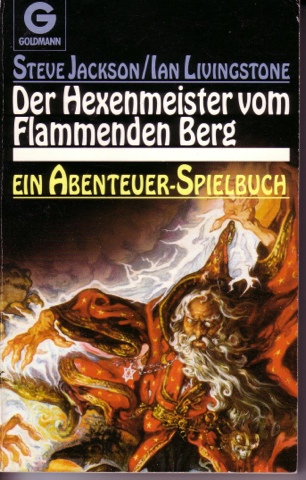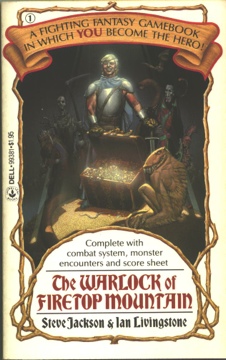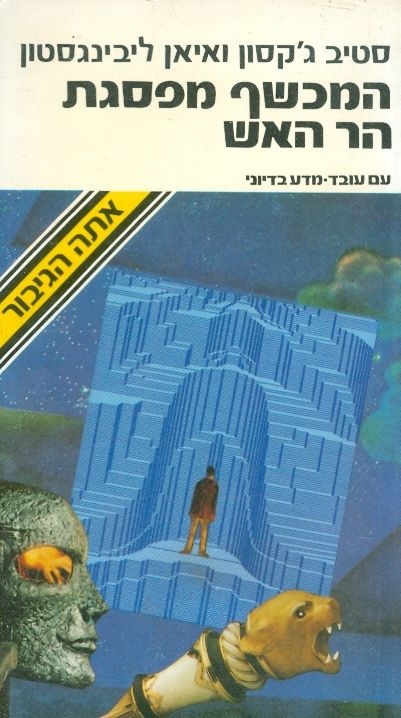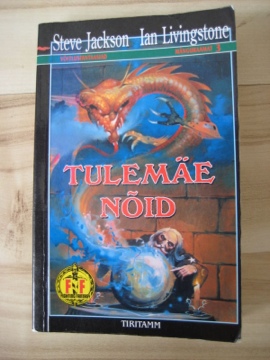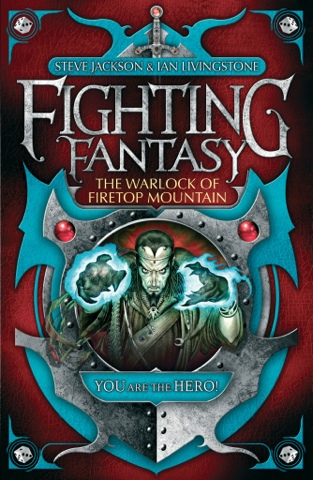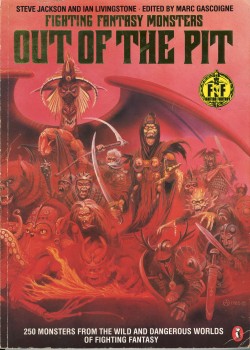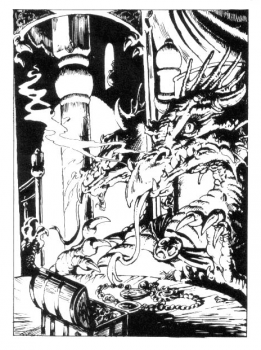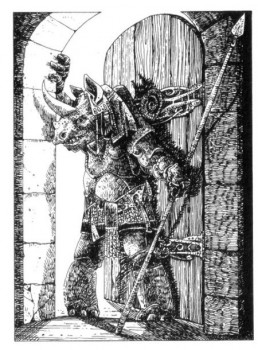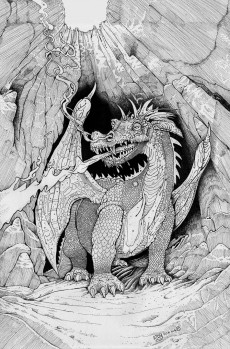…and over 70% of the price was ‘shipping and handling’ 🙂
Anyway, here’s the proof:
And yes, I know one is missing from that photo. Every single one of these was purchased from Amazon, and all but one came from sellers in the USA. The average book price was about $1.50, and the average shipping cost was about $4. It took about 3 weeks for everything to arrive. Three of the books are (brand) new, and the others used, although many of them are obviously still ‘new’ (even if 20+ years old).
In this rather lengthy entry, I’ll offer opinions on many of these books, most of which I’ve read or played these past few weeks.
Sagard The Barbarian series (I have books 1, 3 and 4)
I was attracted to this series since Gary Gygax was co-writer. Much like Sagas Of The Demonspawn, this is a 4-book gamebook series with a single hero that spans all books, leveling up as you play through them. The writing isn’t terrible, and the stories mostly interesting, but the structure is weak, there is very little section randomization (you are often referred to the next section, or the one after) and the books are short. Combat is often overly easy as well. After finding the first few battles trivial, I simply ended up reading the books from that point on.
Perhaps the most notable thing about these books is that in book four, I found this incredible paragraph:
It’s almost like someone was having a joke on the readers expense?
1-on-1 Gamebooks (I have ‘You are Fafhrd’ and ‘You are Garth’)
TSR may have been late to the gamebook party, but they certainly made up for it with many different ranges of gamebooks. This 1-on-1 series was packaged as a pair of books meant to be played simultaneously (a ripoff of Clash of The Princes, in other words) and based on these two I have read were poorly designed and edited. They both suffer from the usual half-rate gamebook problems of jarring transitions, overt forcing (too many decisions made for the character) and infinite loops. The Fafhrd one in particular is a dreadful Monty-Haul-y city-dungeon hack filled with unlikely scenario upon unlikely scenario. Two ‘for the collection’.
Starlight Adventures (I added books 2 and 4)
I already had a couple of books in this ‘FF for the girls’ series. There’s no combat, and the game ‘system’ utilizes only your Zodiac sign and lucky number, but after reading book 2 thoroughly I have to say the series hardly falters for lack of complexity. You play a private detective on the search of a missing heir, and the search takes you around the world (including through Albany, NY!) and into the world of a traveling rock-and-roll band. ‘Failure’ in these books doesn’t mean death, it just means your life took some alternate path (like, no joke, marrying a wealthy oil baron you meet in a Vegas casino)! I liked it a lot, and plan to read the others I have in the series.
AD&D Gamebooks (I added 1, 9, 11, 12 and 18)
I already had a few in this series (and the Marvel Super Heroes series, which uses the same system) and added five more. Inexplicably, although high numbered books in this series can fetch ridiculous ($100+) prices, I was able to get the last book published, Prince Of Thieves, for a song. The books are neither bad nor good, and notable for a style of writing that tends more toward prose and contains far less combat than gamebooks that originated in England. I like that the series sets different books in different AD&D worlds, although I wish they’d written a Spelljammer one when they had the chance!
Virtual Reality (book 3)
Staggeringly thinly-veiled allegorical story in which you, messianic representative of the oppressed ‘Judain’, lead a rebellion against ‘The Overlord’ and ultimately the physical embodiment of ‘Hate’ (the thing on the cover). At one point, you are emboldened by finding and reading a magical text called Song Of Suleimon. No I’m not joking! A very depressing and dreary book, in which most allies or even acquaintances die and the final, good ending feels like a bitter pill. Amusing since the author clearly tries to shoe-horn fantasy tropes (giant spiders, crystal golems) into a work that would probably have been better served as a (bad) novel. In short: another curious installment in a most curious series.
Catacombs (Book 3)
Another weirdo gamebook series from TSR. I have one already, the astonishingly-well-illustrated Fairy Mound Of Dragonkind, but am glad to now own the only ever Top Secret (an old 1980s TSR RPG) gamebook in the form of book 3 of this series, The Final Bug. I tried to play this one in full, but about half-way through the impossibly complex rules – which involve a dossier of secret documents (stored inside the back cover) and a villian’s complex that you assemble room-by-room using random die rolls – led me to continue by simply reading. Very well written, very interesting, and probably one of the more complex gamebooks every written. I’m happy my copy is essentially mint, including most of the secret documents still being sealed 🙂
The Renegade Wizard
This gamebook was published only months ago, and is the first of a proposed series. My opinion: If you’re going to write a new gamebook in 2012 you had better make sure it’s better than the hundreds that came before it (such as Destiny Quest). In that sense, this book fails miserably. The author throws a very average Warlock Of Firetop Mountain clone at players, full of all the cliches and inconsistencies that gamebooks should have evolved beyond. It’s lengthy (over 500 entries) and reasonably well written, but lacks a soul and is ultimately a disappointment. I’m not sure a second book in this series will ever exist. Oh, and there’s hardly no illustrations, including zero full page ones 🙁
Fabled Lands (books 5 and 6)
No comment, except to say that all installments in this superb series have now been republished. Get them while you can!
Treachery in Drakenwood (book 1)
I haven’t played it yet, but this is one of two (I have the other coming in a few days…) in a series from 1985 that is viewed highly by enthusiasts. Much like Fabled Lands, the player is free to explore as he sees fit, and careful notes (and a map!) must be kept since locations can be revisited. The game system looks satisfying complex and I look forward to playing both once I have the whole series (although, unlike Fabled Lands, the books are not connected).
Oh, and the art is terrible. As in I could almost draw better terrible:
Car Wars (book 1)
Flipping through this, the first in a series of 6 books written by Steve ‘the American one’ Jackson, I was intrigued by the complexity of the system, especially combat. Lots of statistics, combat diagrams and damage maps to keep track of. Then I played the game, beat it in one sitting, and only got into one very brief fight! That said, I enjoyed this quite a bit. The story is suitably gonzo (as if Mad Max was set in the US) and the pace quite leisurely without abandoning a strange and constant menace due to the setting. I’m not sure if my first-play victory was dumb luck or if the book is easy, but I liked it enough I’m interested in others of the series.
I also purchased a few other books in my mega-order, as you may have noticed in the photo at the top. These included another Lone Wolf (I now have the first 20), some more Middle Earth series books, Bloodfeud Of Altheus (book 1 of Cretan Chronicles) and Dragon Warriors book 2. And lastly, this gem:
A case of gamebooks expanding into genres they had no right venturing into perhaps? We shall see…
